The Impact of Supply Voltage Waveform Distortion on Non-Intentional Emission in the Frequency Range 2–150 kHz: An Experimental Study with Power-Line Communication and Selected End-User Equipment
Abstract
:1. Introduction
- Improving the security of the system by increasing its observability.
- The use of demand side management (DSM) tools, which is carried out by dynamic billing of electricity consumers and prosumers.
- Forecasting the amount of energy released to the grid by micro-installations.
2. Literature Review
2.1. Gap in the Research Related to Influence of Supply Voltage Distortion on Supraharmonics Emission
2.2. The Background of the Investigations—Identification of the Emission Limits, Compatibility Levels, and Immunity Levels for Conducted Disturbances and Signalling in the Frequency Range 2–150 kHz
- Levels of non-intentional emission referring to individual equipment and the power grid (non-intentional emission).
- Compatibility levels in the power grids (compatibility levels, environment characteristics).
- Intentional emission (transmission levels and mains signalling).
- Immunity test levels.
- Compatibility levels referring to IEC 61000-2-2: AMD1:2017 [5] and AMD2:2018 (dashed line, pink colour, letter “C”).
- Levels of tests for immunity to conducted, differential mode disturbances, and signalling in the frequency range 2 kHz to 150 kHz at AC power ports referring to PN–EN 61000-4–19:2014 [6] (solid line, black colour, notation “P4”—test level with the reference to environment class 4: severe industrial environment; dashed line, colour black—notation “P3”—test level with the reference to environment class 3: typical residential, commercial, and light industrial environment).
3. Characteristic of the Laboratory Hardware and Software Setup
- LED light sources (the three-phase circuit was made using three single-phase LED with a power of 8 W connected in a star, the LED have implemented active power factor correction by an active power filter (APF) in order to keep cosφ = 0.9).
- CFL compact fluorescent lamps (the three-phase circuit was made of three single-phase compact fluorescent lamps with the power of 11 W, 18 W and 20 W connected in a star).
- Three-phase asynchronous induction motor 300 W/400 V/50 Hz rated speed 1390 rpm, powered by a single-phase frequency converter with input voltage 230 V, output voltage 3 × 230 V, power 400 W.
4. Results of an Experimental Study with Power-Line Communication and Selected End-User Equipment
- Supply voltage scenario 1: pure sinusoidal voltage.
- Supply voltage scenario 2: distorted voltage with harmonics according to permissible limits for public networks defined in EN 50160 [3].
- Supply voltage scenario 3: distorted voltage with harmonics used for immunity tests of load according to IEC 61000-4-13 [30]—equipment with the third class of immunity.
- Load condition 0: no load.
- Load condition 1: LED light source.
- Load condition 2: compact fluorescent lamp (CFL) light source.
- Load condition 3: induction motor powered by a frequency converter.
- Increasing the number of attempted connections is the preventive action of the PLC system to keep the transmission successful and can be interpreted as a symptom of deteriorated transmission condition.
- Percentage contribution of the number of failed connections is not directly representative quantity indicating the deterioration of the transmission condition due to increasing number of attempted connections.
- Increasing the duration of failed connections is the direct symptom of the problems with continuity of the communication (referring to ADDAX recommendation the threshold value for the duration of failed connections indicating communication problem is 180 s in one hour).
4.1. Case 1 (Supply Voltage Scenario 1, Load Condition 0): Operation of the Tested PRIME PLC System without Loads during Sinusoidal Supply Voltage—Reference Analysis
- Local maximum of the non-intentional emission level (noise, background): Nmax = 65.72 dBµV.
- The intentional transmission signal level related to Nmax: S(Nmax) = 87.51 dBµV.
- Local minimum signal-to-noise ratio: SNRlocal = 21.79 dB.
- Signal-to-noise ratio in the full transmission band: SNRband = 31.21 dB.
4.2. Case 2 (Supply Voltage Scenario 1, Load Condition 1): Operation of the Tested PRIME PLC System with LED Light Sources during Sinusoidal Supply Voltage
- Local maximum of the non-intentional emission level (noise, background): Nmax = 75.63 dBµV.
- The intentional transmission signal level related to Nmax: S(Nmax) = 92.67 dBµV.
- Local minimum signal-to-noise ratio: SNRlocal = 17.04 dB.
- Signal-to-noise ratio in the full transmission band: SNRband = 30.63 dB.
- Statistics of the connection in the presented case are expressed by:
- Total number of the connections: 53 (including 44 successful and 9 failed connections).
- Duration of failed connections in one hour: 2 s.
4.3. Case 3 (Supply Voltage Scenario 2, Load Condition 1): Operation of the Tested PRIME PLC System with LED Light Sources during Distorted Supply Voltage Referring to Permissible Limits for Public Grid EN 50160
- Local maximum of the non-intentional emission level (noise, background): Nmax = 77.08 dBµV.
- The intentional transmission signal level related to Nmax: S(Nmax) = 93.55 dBµV.
- Local minimum signal-to-noise ratio: SNRlocal = 16.47 dB.
- Signal-to-noise ratio in the full transmission band: SNRband = 23.57 dB.
- Total number of the connections: 103 (including 83 successful and 20 failed connections).
- Duration of failed connections in one hour: 187 s.
4.4. Case 4 (Supply Voltage Scenario 4, Load Condition 1) Operation of the Tested PRIME PLC System with LED Light Sources during Distorted Supply Voltage Referring to Immunity Test Limits
- Local maximum of the non-intentional emission level (noise, background): Nmax = 89.82 dBµV.
- The intentional transmission signal level related to Nmax: S(Nmax) = 92.96 dBµV.
- Local minimum signal-to-noise ratio: SNRlocal = 3.14 dB.
- Signal-to-noise ratio in the full transmission band: SNRband = 7.61 dB.
- Total number of the connections: 106 (including 86 successful and 20 failed connections).
- Duration of failed connections in one hour: 371 s.
4.5. Comparative Analysis: Operation of the Tested PRIME PLC System under the Different Scenario of Supply Voltage Distortion and Variant Types of Loads
- No-load and sinusoidal supply voltage (reference condition)—1 case.
- LED light sources (sinusoidal, EN 50160, IEC 61000 4-13)—3 cases.
- CFL light sources (sinusoidal, EN 50160, IEC 61000 4-13)—3 cases.
- Induction motor powered by PWM (sinusoidal, EN 50160, IEC 61000 4-13)—3 cases.
- With LED load the SNR coefficient decreased from 30.06 dB (SNRband)/17.04 dB (SNRlocal) for the sinusoidal normal condition to 7.61 dB(SNRband)/3.14 dB (SNRlocal) for margin distorted condition, which made PLC transmission more difficult;
- With CFL load the SNR coefficient decreased from 26.31 dB (SNRband)/20.61 dB (SNRlocal) for the sinusoidal normal condition to 9.73 dB (SNRband)/2.94 dB (SNRlocal) for margin distorted condition, which made PLC transmission more difficult;
- With induction motor powered by PWM converter, the SNR coefficient decreased from 18.97 dB (SNRband)/10.11 dB (SNRlocal) for the sinusoidal normal condition to 2.49 dB (SNRband)/−0.79dB (SNRlocal) for margin distorted condition, which made PLC transmissions impossible.
- With LED load the number of attempted connections increased two times and the duration of failed connections increased from 2 s to 371 s when the distortion of the supply voltage was increasing;
- With CFL load the number of attempted connections were relatively higher than in the case of LED load and the duration of failed connections increased from 186 s to 366 s;
- With induction motor powered by PWM converter the duration of the failed connections obtained the highest value of 551 s noticed under the distorted supply condition. Additionally, in the case of the margin-investigated supply voltage distortion, the PLC system was not able to retry the connections and the number of the attempted connection was relatively small.
5. Discussion
- For all investigated loads (CFL, LED, the motor with PWM) it was observed that increasing the content of higher harmonics in the supply voltage from the sinusoidal condition, by the waveform distortion representing permissible content of harmonic in a public grid, to the waveform distortion defined in the immunity test of the equipment, resulted in a higher level of non-intentional emission in the range 2–150 kHz. As a consequence, the SNR derived from the local maximum magnitude of the background signal and associated with it the local magnitude of the transmission signal of the investigated PRIME PLC system was consistently decreasing, from 17.04 dB to 3.14 dB (for LED), from 20.61 dB to 2.94 dB (for CFL) and from 10.11 dB to −0.79 dB (for the motor with PWM). The SNR calculated on the basis of power of the transmission signal and power of the background signal in the transmission band was also decreasing, from 30.06 dB to 7.61 dB (for LED), from 26.31 dB to 9.73 dB (for CFL), and from 18.97 dB to 2.49 dB (for the motor with PWM), respectively.
- An indirect result of the supply voltage distortion is an increasing number of the connections activated by the investigated PLC system in order to prevent loss of the connection. However, in case of a high level of supply voltage distortions, the duration of the failed connections increased significantly. The duration of failed connections decreased from 2 s to 371 s for the LED load, and from 186 s to 366 s for the CFL load. The highest value of the duration of failed connections, 551 s, was achieved in the case of the induction motor powered by PWM.
- The scenarios of the supply voltage distortion used in the investigation represent a relatively high level of deterioration (direct sum of harmonics permissible harmonic for public grid is represented by THD equals 11.62%; voltage distortion used in the immunity test equipment of the third class of immunity is represented by THD equals 25.69%). However, the formulated relation between the condition of the supply voltage and non-intentional emission suggests extending the discussion about the condition of the tests of non-intentional emissions, which currently are performed under sinusoidal conditions. A proposition for an extended test using deteriorated supply voltage, referring to the permissible level of THD in a low-voltage public network, gradually increasing from a few percentage points to 8%, can be considered.
- The proposition of extended testing of non-intentional emissions under a distorted supply voltage might also be valuable for a more effective filter specification and selection for particular power line communication technologies.
Author Contributions
Funding
Data Availability Statement
Acknowledgments
Conflicts of Interest
References
- Benchmarking smart metering deployment in the EU-28. In Final Report, European Commission, Directorate-General for Energy, Directorate B—Internal Energy Market Unit B.3—Retail Markets; Coal & Oil; Publications Office of the European Union: Luxembourg, Luxembourg, 2020. [CrossRef]
- EN 50065-1:2012. Signalling on Low-Voltage Electrical Installations in the Frequency Range 3 kHz to 148.5 kHz—Part 1: General Requirements; Frequency Bands and Electromagnetic Disturbances; CEN-CENELEC Management Centre: Brussels, Belgium; BSI: London, UK, 2011. [Google Scholar]
- EN 50160: 2010. Voltage Characteristics of Electricity Supplied by Public Distribution Systems; CEN-CENELEC Management Centre: Brussels, Belgium, 2010. [Google Scholar]
- IEC 61000-3-8: 1997. Part 3: Limits—Section 8: Signalling on Low-Voltage Electrical Installations—Emission Levels, Frequency Bands and Electromagnetic Disturbance Levels; International Electrotechnical Commission: Geneva, Switzerland; BSI: London, UK, 1997. [Google Scholar]
- IEC 61000-2-2: AMD1:2017. Part 2-2: Environment—Compatibility Levels for Low-Frequency Conducted Disturbances and Signalling in Public Low-Voltage Power Supply Systems; International Electrotechnical Commission: Geneva, Switzerland, 2017. [Google Scholar]
- IEC 61000-4-19:2014. Part 4-19: Testing and Measurement Techniques—Test for Immunity to Conducted, Differential Mode Disturbances and Signalling in the Frequency Range 2 kHz to 150 kHz at a.c. Power Ports; International Electrotechnical Commission: Geneva, Switzerland, 2014. [Google Scholar]
- Meyer, J.; Khokhlov, V.; Klatt, M.; Blum, J.; Waniek, C.; Wohlfahrt, T.; Myrzik, J. Overview and Classification of Interferences in the Frequency Range 2–150 kHz (Supraharmonics). In Proceedings of the International Symposium on Power Electronics; Electrical Drives; Automation and Motion (SPEEDAM), Amalfi, Italy, 20–22 June 2018; pp. 165–170. [Google Scholar]
- Rönnberg, S.K.; Bollen, M.H.; Amaris, H.; Chang, G.W.; Gu, I.Y.; Kocewiak, Ł.H.; Meyer, J.; Olofsson, M.; Ribeiro, P.F.; Desmet, J. On waveform distortion in the frequency range of 2–150 kHz. Review and research challenges. Electr. Power Syst. Res. 2017, 150, 1–10. [Google Scholar] [CrossRef]
- Alfieri, L.; Bracale, A.; Carpinelli, G.; Larsson, A. Accurate assessment of waveform distortions up to 150 kHz due to fluorescent lamps. In Proceedings of the 6th International Conference on Clean Electrical Power (ICCEP), Santa Margherita Ligure, Italy, 27–29 June 2017. [Google Scholar]
- Alfieri, L.; Bracale, A.; Varilone, P.; Leonowicz, Z.; Kostyla, P.; Sikorski, T.; Wasowski, M. Methods for Assessment of Supraharmonics in Power Systems. Part I: Theoretical Issues. In Proceedings of the 7th International Conference on Clean Electrical Power (ICCEP), Otranto, Italy, 2–4 July 2019; pp. 117–122. [Google Scholar]
- Alfieri, L.; Bracale, A.; Varilone, P.; Leonowicz, Z.; Kostyla, P.; Sikorski, T.; Wasowski, M. Methods for Assessment of Supraharmonics in Power Systems. Part II: Numerical Applications. In Proceedings of the 7th International Conference on Clean Electrical Power (ICCEP), Otranto, Italy, 2–4 July 2019; pp. 123–128. [Google Scholar]
- Angulo, I.; Arrinda, A.; Fernandez, I.; Uribe-Perez, N.; Arehalde, I.; Hernandez, L. A review of measurement technique for non-intentional emissions above 2 kHz. In Proceedings of the IEEE International Energy Conference, Leuven, Belgium, 4–8 April 2016.
- Grevener, A.; Meyer, J.; Ronberg, S. Comparison of measurement methods for the frequency range 2–150 kHz (Supraharmonics). In Proceedings of the IEEE 9th International Workshop on Applied Measurements for Power Systems, Bologna, Italy, 26–28 September 2018. [Google Scholar]
- IEC 61000-4-7/A1:2009. General Guide on Harmonics and Interharmonics Measurements and Instrumentation; International Electrotechnical Commission: Geneva, Switzerland, 2009. [Google Scholar]
- IEC 61000-4-30:2015. Part 4-30: Testing and Measurement Techniques—Power Quality Measurement Methods; International Electrotechnical Commission: Geneva, Switzerland, 2015. [Google Scholar]
- Bollen, M.; Rönnberg, S. Propagation of Supraharmonics in the Low Voltage Grid. In Proceedings of the Energiforsk, Stockholm, Sweden, 25 January 2017. [Google Scholar]
- Gil-de-Castro, A.; Medina-Gracia, R.; Rönnberg, S.K.; Blanco, A.M.; Meyer, J. Differences in the performance between CFL and LED lamps under different voltage distortions. In Proceedings of the 18th International Conference on Harmonics and Quality of Power (ICHQP), Ljubljana, Slovenia, 13–16 May 2018. [Google Scholar] [CrossRef] [Green Version]
- Gil-de-Castro, A.; Rönnberg, S.K.; Bollen, M.H.J. Harmonic interaction between an electric vehicle and different domestic equipment. In Proceedings of the International Symposium on Electromagnetic Compatibility, Chiyoda, Tokyo, Japan, 12–16 May 2014. [Google Scholar]
- Gil-de-Castro, A.; Rönnberg, S.K.; Bollen, M.H.J. A study about harmonic interaction between devices. In Proceedings of the 16th International Conference on Harmonics and Quality of Power (ICHQP), Bucharest, Romania, 25–28 May 2014. [Google Scholar]
- IEC CLC/TR 50669:2017. Technical Report. Investigation Results on Electromagnetic Interference in the Frequency Range below 150 kHz; CEN-CENELEC Management Centre: Brussels, Belgium, 2017. [Google Scholar]
- Andersson, M.O.J.; Rönnberg, S.K.; Lundmark, C.M.; Larsson, E.O.A.; Wahlberg, M.; Bollen, M.H.J. Interfering signals and attenuation—potential problems with communication via the power grid. In Proceedings of the 19th International Conference on Electricity Distribution, Vienna, Austria, 21–24 May 2007. [Google Scholar]
- López, G.; Moreno, J.I.; Sánchez, E.; Martínez, C.; Martín, F. Noise Sources, Effects and Countermeasures in Narrowband Power-Line Communications Networks: A Practical Approach. Energies 2017, 10, 1238. [Google Scholar] [CrossRef] [Green Version]
- Rönnberg, S.K.; Bollen, H.H.J.; Wahlberg, M. Interaction between Narrowband Power-Line Communication and End-User Equipment. IEEE Trans. Power Deliv. 2011, 26, 20134–22039. [Google Scholar] [CrossRef]
- Shklyarskiy, Y.; Hanzelka, Z.; Skamyin, A. Experimental Study of Harmonic Influence on Electrical Energy Metering. Energies 2020, 13, 5536. [Google Scholar] [CrossRef]
- Uribe-Pérez, N.; Angulo, I.; Hernández-Callejo, L.; Arzuaga, T.; De la Vega, D.; Arrinda, A. Study of Unwanted Emissions in the CENELEC-A Band Generated by Distributed Energy Resources and Their Influence over Narrow Band Power Line Communications. Energies 2016, 9, 1007. [Google Scholar] [CrossRef] [Green Version]
- Thai, M.T.; Wu, W.; Xiong, H. (Eds.) Big Data in Complex and Social Networks, 1st ed.; CRC Press: Boca Raton, FL, USA, 2016. [Google Scholar]
- Blanco, A.M.; Gupta, M.; de Castro, A.G.; Rönnberg, S.K.; Meyer, J. Impact of flat-top voltage waveform distortion on harmonic current emission and summation of electronic household appliances. In Proceedings of the International Conference on Renewable Energies and Power Quality ICREPQ’18, Salamanca, Spain, 21–23 March 2018. [Google Scholar]
- Mansoor, A.; Grady, W.M.; Thallam, R.S.; Doyle, M.T.; Krein, S.S.; Samotyj, M.J. Effect of Supply Voltage Harmonics on the Input Current of Single-phase Diode Bridge Rectifier Loads. IEEE Trans. Power Deliv 1995, 10, 1416–1422. [Google Scholar] [CrossRef]
- Huang, X.-L.; Ma, X.; Hu, F. Machine learning and intelligent communications. Mob. Netw. Appl. 2018, 23, 68–70. [Google Scholar] [CrossRef] [Green Version]
- IEC 61000-4-13:2002 & A1:2009 & A2:2015. Electromagnetic Compatibility (EMC): Testing and Measurement Techniques. Harmonics and Interharmonics Including Mains Signalling at a.c. Power Port; Low-Frequency Immunity Tests; International Electrotechnical Commission: Geneva, Switzerland, 2002. [Google Scholar]
- Yanchenko, S.; Meyer, J. Harmonic Emission of Household Devices in Presence of Typical Voltage Distortions. In Proceedings of the 2015 IEEE PowerTech Conference, Eindhoven, The Netherlands, 29 June 2015. [Google Scholar]
- KIKUSUI AC Power Supply PRC-LA-Series. Available online: https://www.kikusui.co.jp/common/product/pdf/pcr-la.pdf (accessed on 20 March 2020).
- IEC 61000-3-3:2013. Part 3: Limits—Section 3: Limitation of Voltage Changes, Voltage Fluctuations and Flicker in Public Low-Voltage Supply Systems, for Equipment with Rated Current ≤ 16 A per Phase and Not Subject to Conditional Connection; International Electrotechnical Commission: Geneva, Switzerland; BSI: London, UK, 2013. [Google Scholar]
- KIKUSUI Three-phase Output Driver for PCR-LA Series. Available online: https://https://manual.kikusui.co.jp/I/IB03_PCR_LA_E2.pdf (accessed on 5 January 2021).
- KIKUSUI Quick Immunity Testing Software. Available online: https://www.kikusui.co.jp/en/download/en/?fn=sd003-pcrla_AP (accessed on 5 January 2021).
- KIKUSUI GPIB Interface for PCR-LA Series. Available online: https://manual.kikusui.co.jp/NUMERIC/3P03_PCR_LA_E3.pdf (accessed on 5 January 2021).
- National Instruments NI 9223 Voltage Input Module Datasheet. Available online: https://www.ni.com/pdf/manuals/374223a_02.pdf (accessed on 5 January 2021).
- LEM Voltage Transducer CV 3-1000 Datasheet. Available online: https://www.lem.com/sites/default/files/products_datasheets/cv_3-1000.pdf (accessed on 5 January 2021).
- Swemet MFA 500, Spectrum Analyser for PLC 3–500 kHz. Available online: http://en.swemet.se/files/Produkter/produktblad_mfa500_ver1.pdf (accessed on 5 January 2021).
- Signal Hound USB-SA44B Spectrum Analyser Measuring Receiver 1 Hz–4.4 GHz Datasheet. Available online: https://signalhound.com/products/usb-sa44b/ (accessed on 5 January 2021).
- ITU-T G.9904 (10/2012) Narrowband Orthogonal Frequency Division Multiplexing Power Line Communication Transceivers for PRIME Networks, International Telecommunication Union. Available online: https://www.itu.int/rec/T-REC-G.9904/en (accessed on 17 January 2020).
- PRIME Alliance Specification for PoweRline Intelligent Metering Evolution, PRIME Alliance Technical Working Group. Available online: https://www.prime-alliance.org/wp-content/uploads/2020/04/PRIME-Spec_v1.4-20141031.pdf (accessed on 17 January 2021).
- SIMS—Smart Integrated Metering System—ADDAX Software Solution Based on up-to-Date Addax Technology for Residential Metering—Datasheet. Available online: www.addgrup.com (accessed on 18 January 2021).
- Korki, M.; Hosseinzadeh, N.; Moazzeni, T. Performance Evaluation of a Narrowband Power Line Communication for Smart Grid with Noise Reduction. IEEE Trans. Consum. Electron. 2011, 57, 4. [Google Scholar] [CrossRef]
- Seijo, M.; López, G.; Matanza, J.; Moreno, J.I. Planning and Performance Challenges in Power Line Communications Networks for Smart Grids. Int. J. Distrib. Sens. Netw. 2016, 2016, 17. [Google Scholar] [CrossRef] [Green Version]
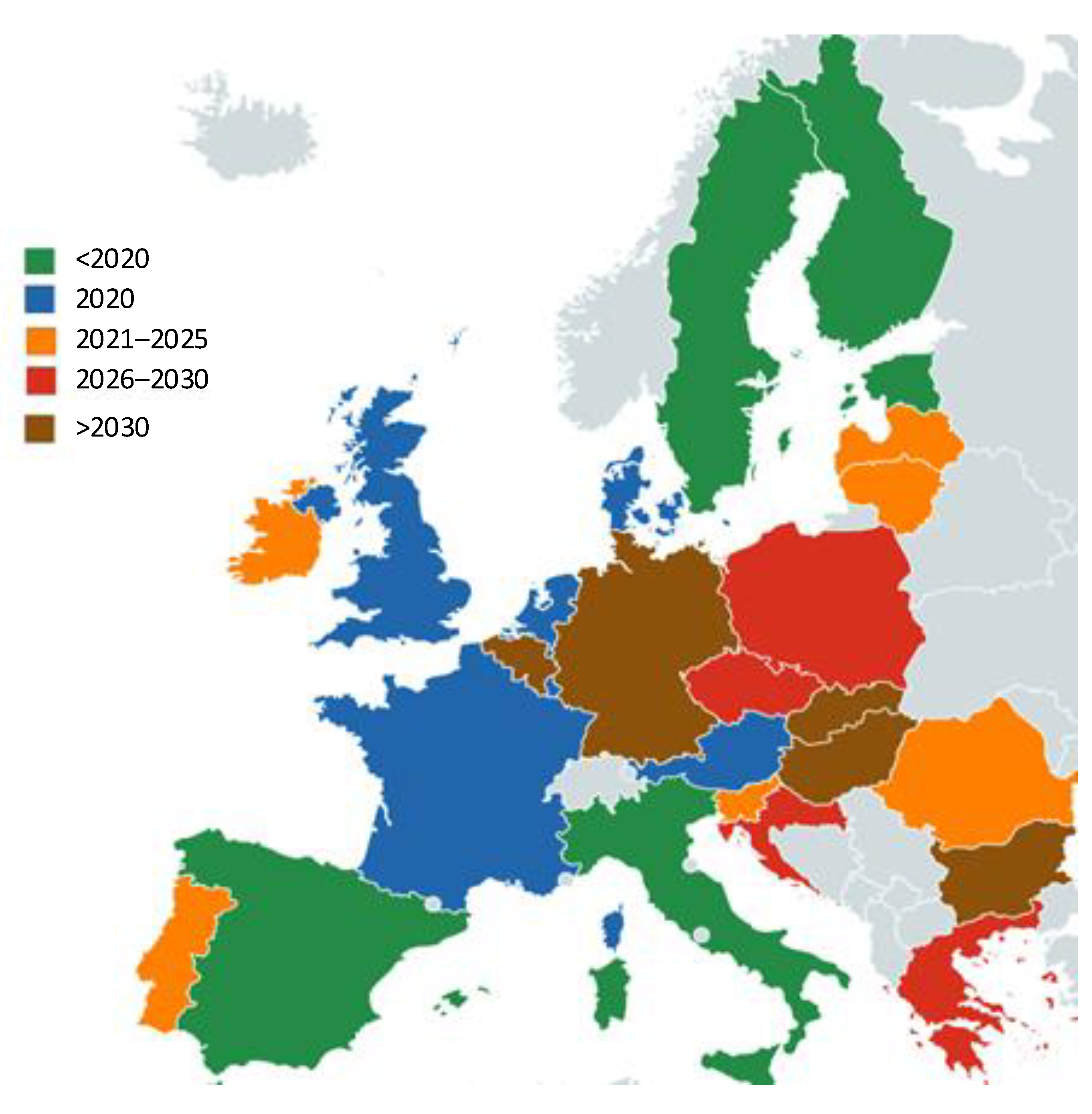

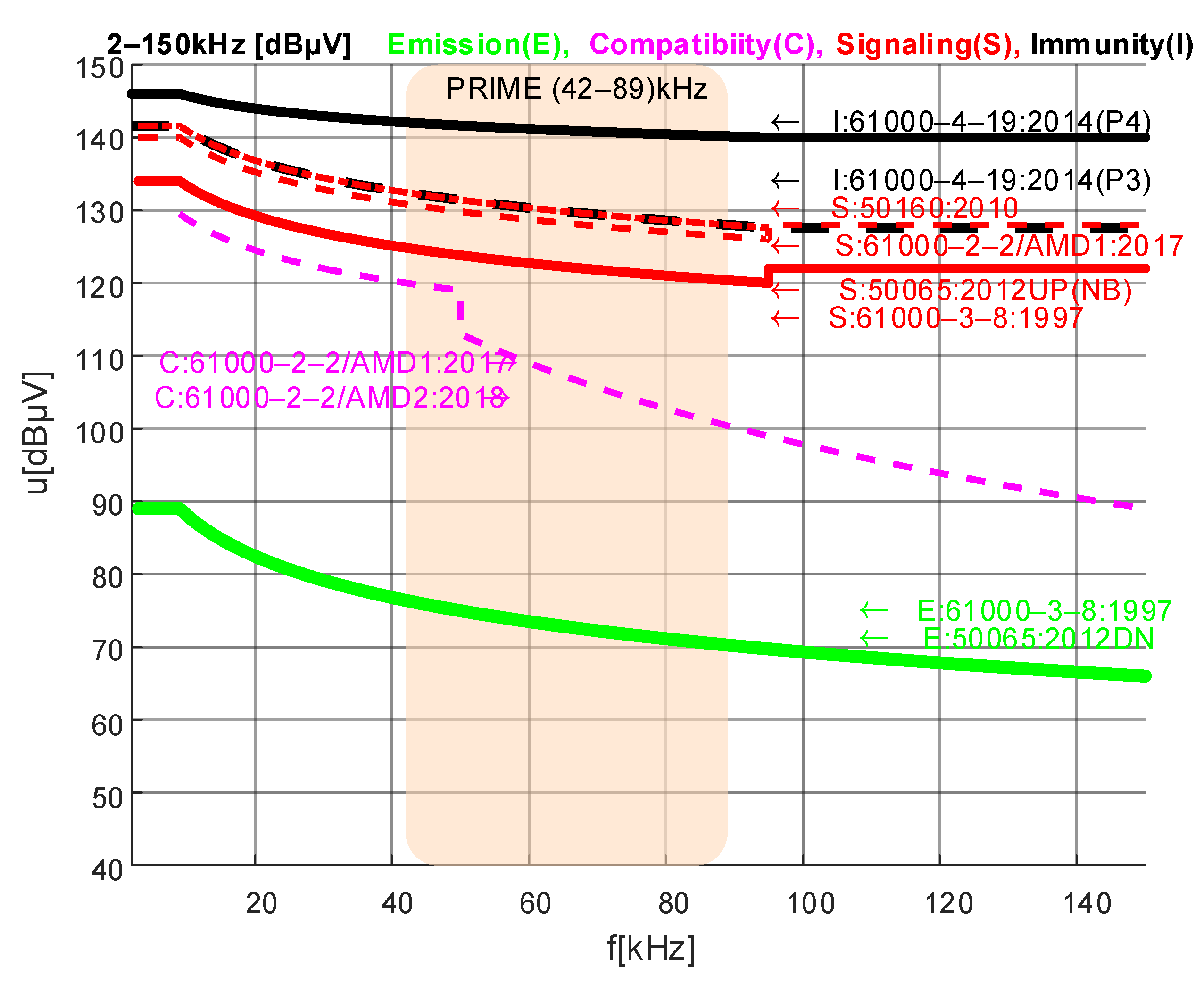
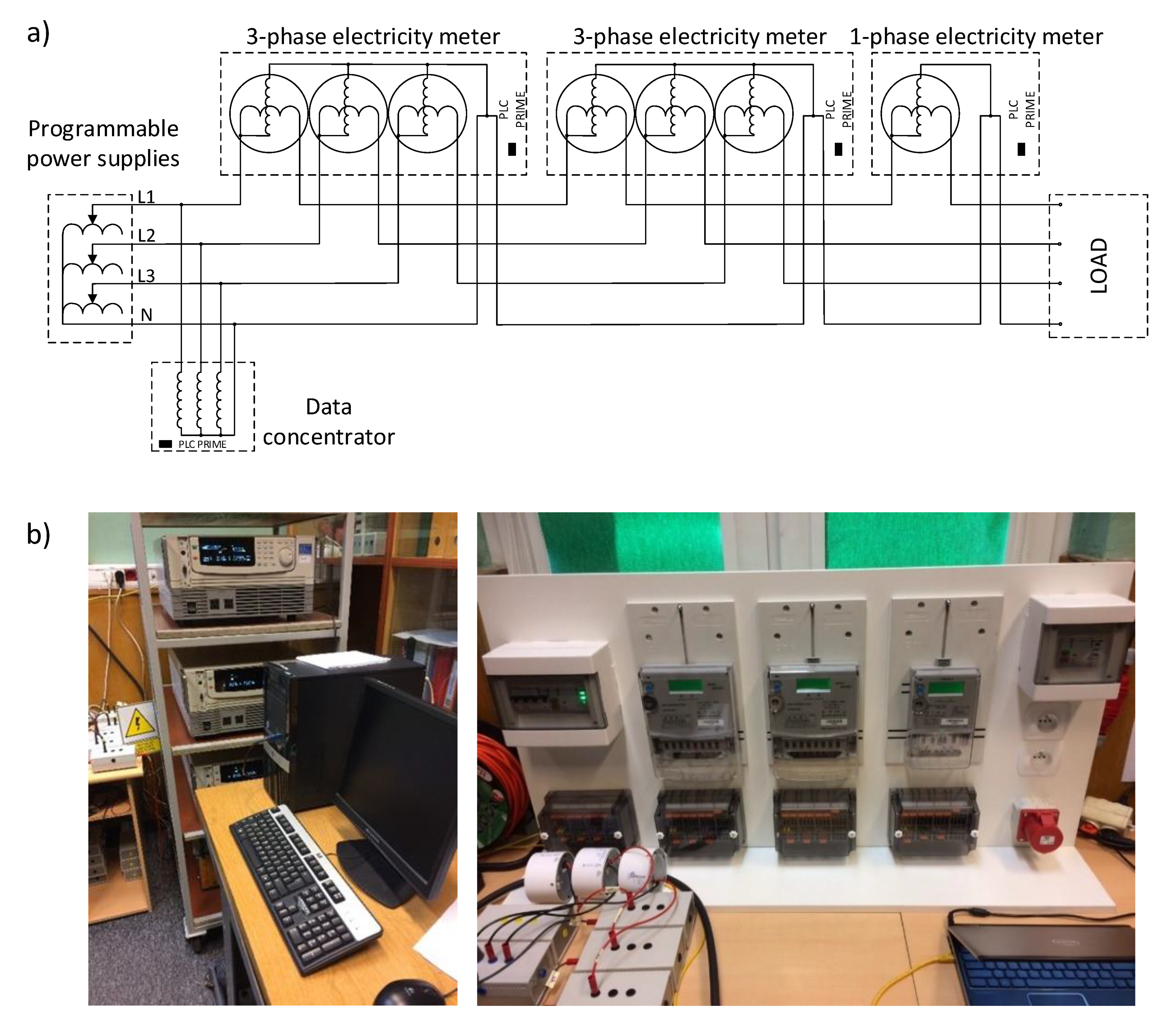
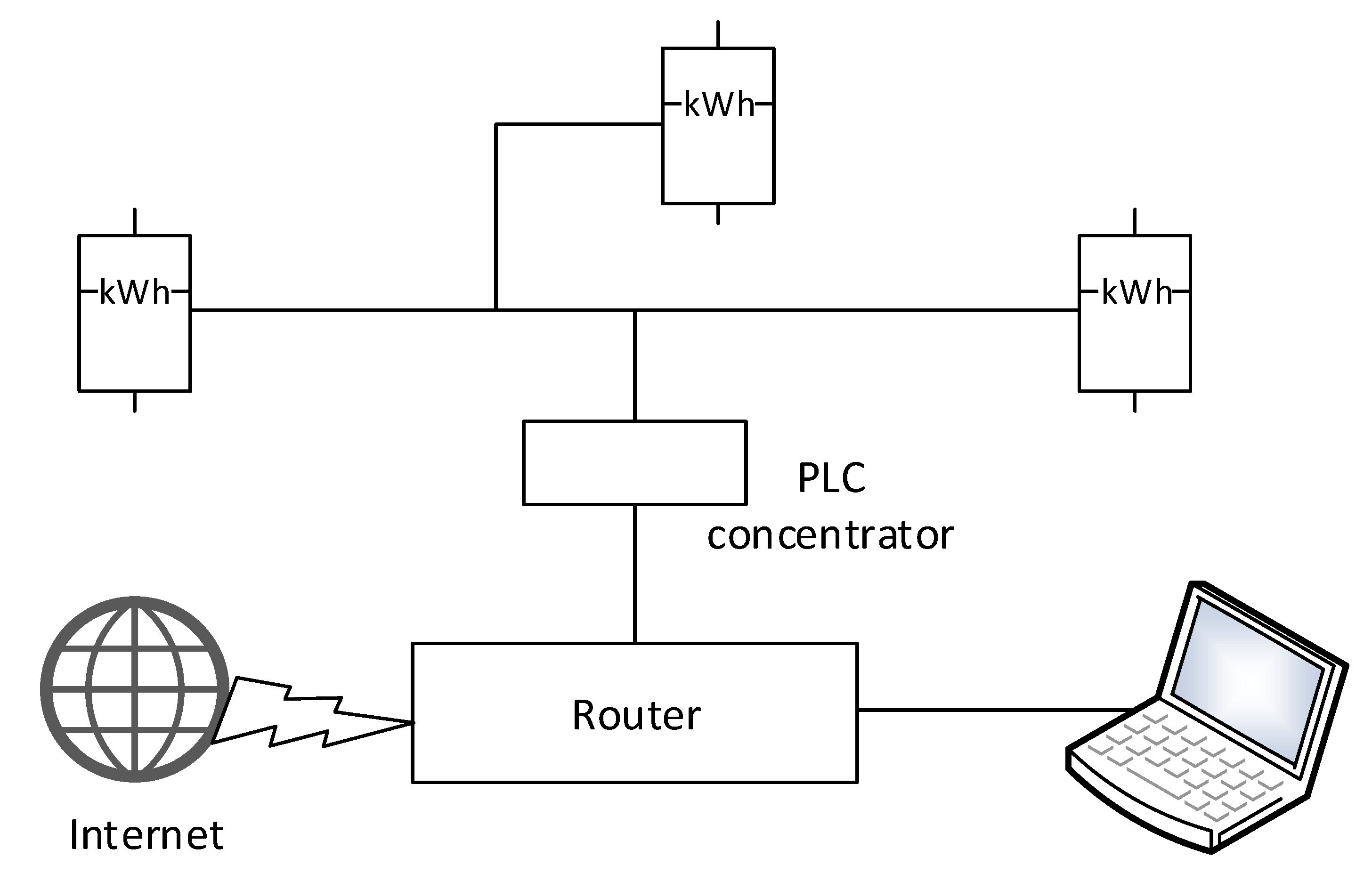


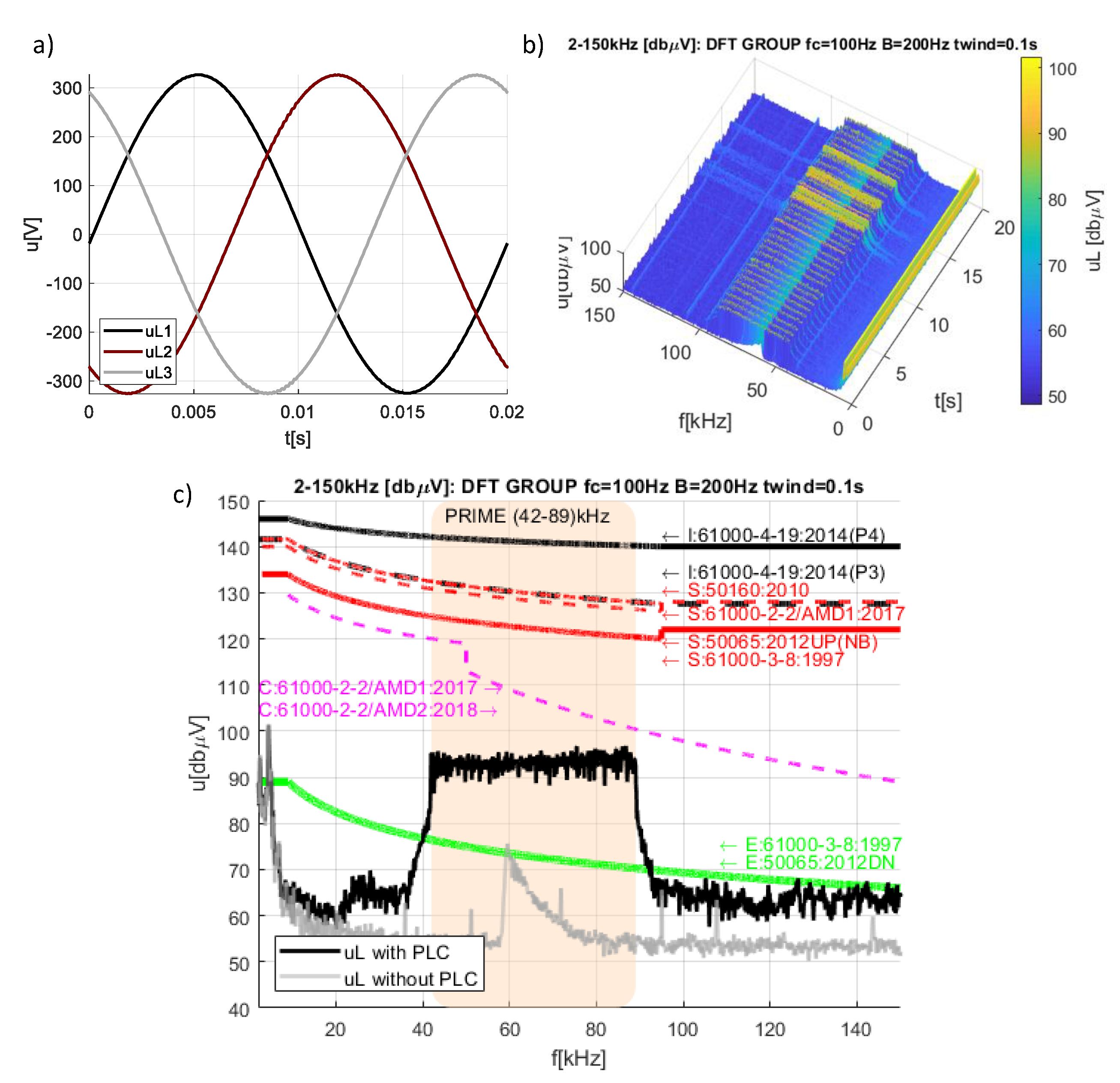

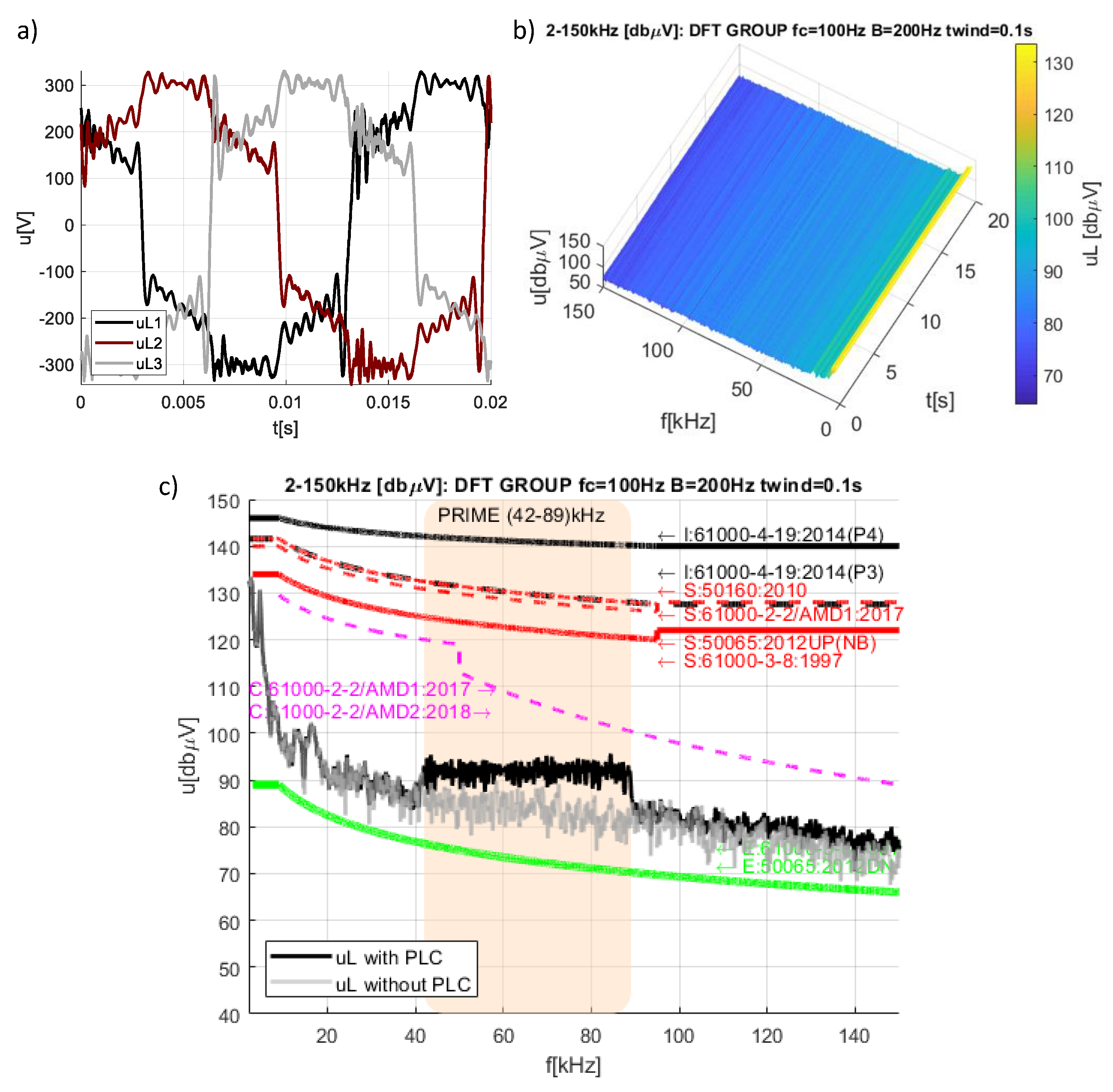
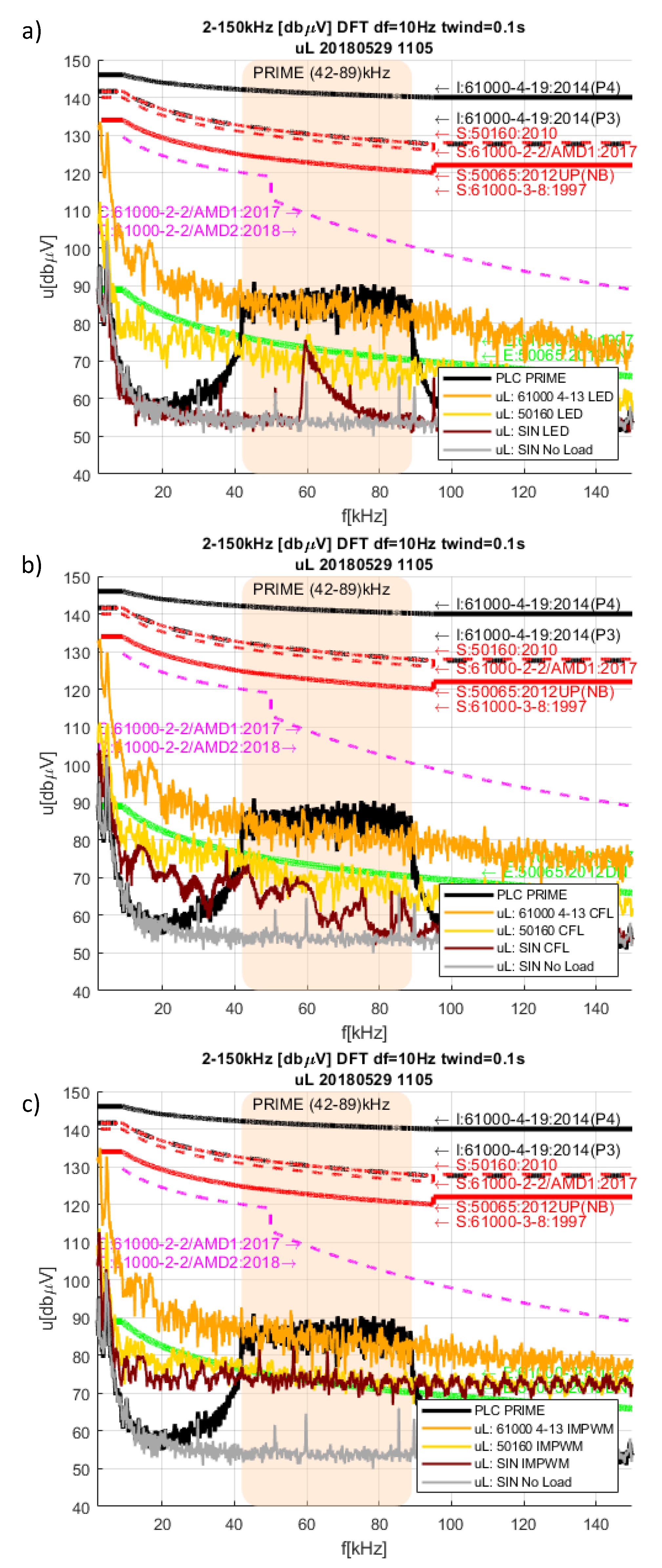
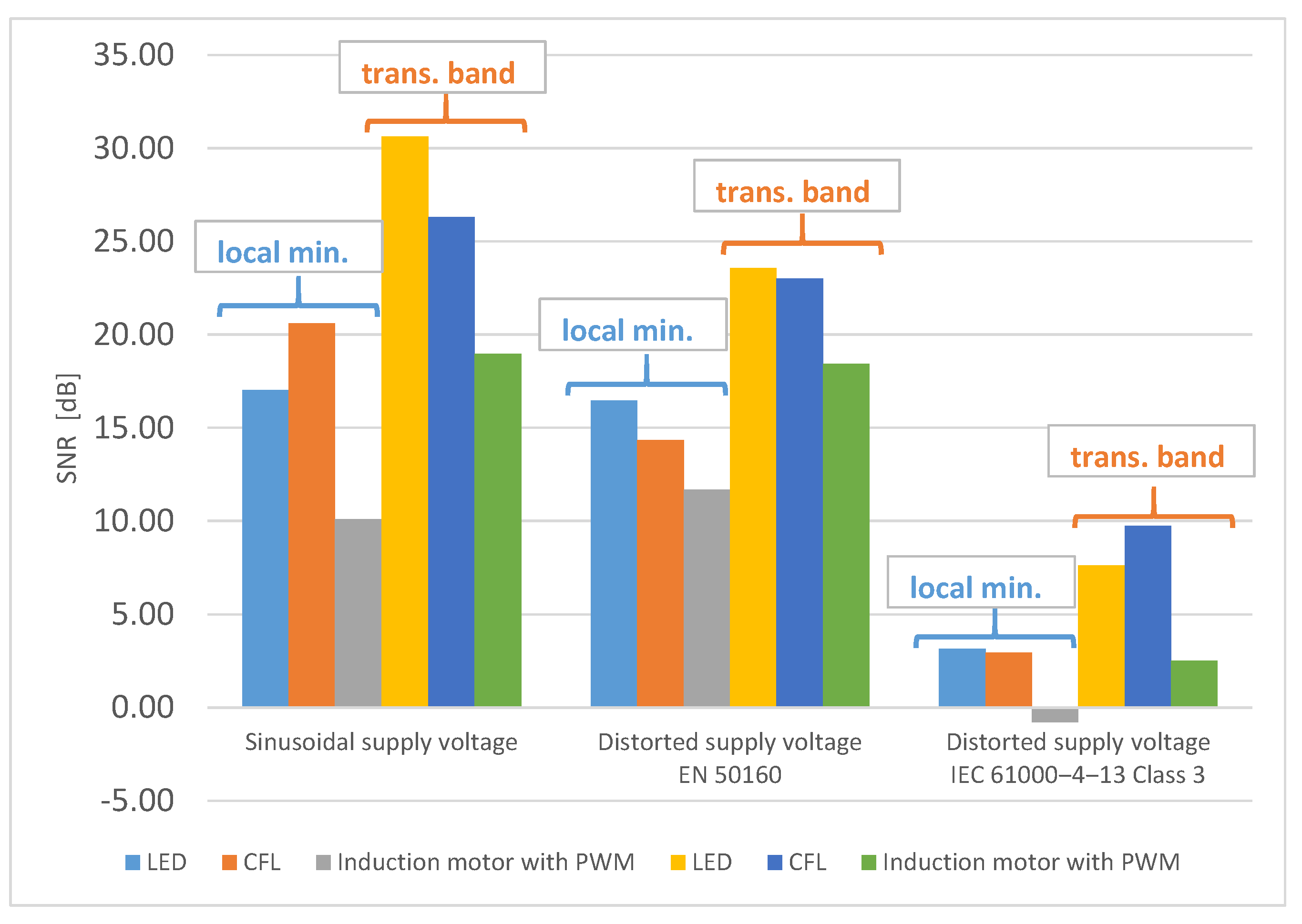
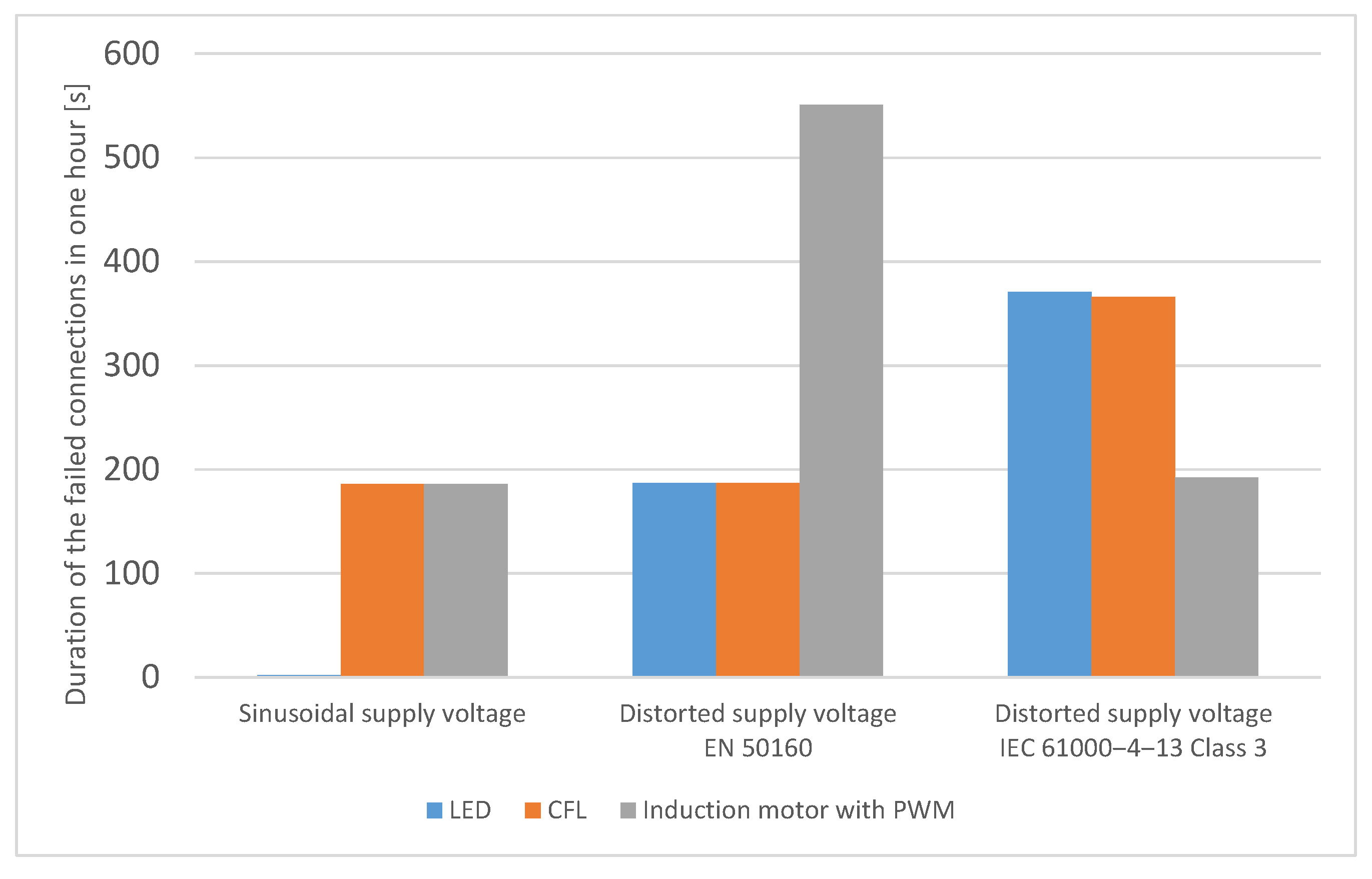
| Programmable AC Source/Kikusui PCR500LA | Specification |
|---|---|
| Power capacity | 500 VA |
| Input voltage variation (with respect to changes in the rated range) | ±0.1% |
| Output current variation (with respect to 0% to 100% changes in the rating) | Within ±0.1 V/±0.2 V (output voltage range 100 V/200 V) |
| Output frequency variation in AC mode (40–999.9 Hz) | Within ±0.3% |
| Ripple noise: DC mode (5 Hz to 1 MHz component) | 0.1 Vrms or less |
| Output frequency stability (with respect to changes in the rated range) | Within ±5 × 10−5 |
| Output voltage waveform distortion | 0.3% or less |
| Output voltage response speed | 30 µs |
| Compliant standards | EMC Directive 89/336/EEC EN61326:1997/A2:2001 Emission Class A IEC 61000-3-2:2000 IEC 61000-3-3:1995/A:2001 |
| Reference impedances/authorised university solution | Specification |
| Nominal frequency | 50 Hz |
| Nominal RMS current | 5 A |
| Nominal impedance | Phase wire zA = (0.24 + j0.15)Ω for 50 Hz RA = 240 mΩ ± 0.2%, LA = 477.5 µH ± 1% Neutral wire zN = (0.16 + j0.10) Ω for 50 Hz RN = 160 mΩ ± 0.2%, LN = 318.3 µH ± 1% |
| Signal recorder/authorised university solution | Specification |
| FPGA platform | National Instrument cRIO FPGA 1 MS/s |
| Voltage input module | National Instrument NI-9223 C Series ±10 V, 1 MS/s, 16-Bit, Simultaneous Input, 4-Differential Channel |
| Voltage Transducer | LEM CV 3–1000 Primary voltage ±1000 V Secondary voltage ±10 V Frequency bandwidth DC ÷ 500 kHz Accuracy 0.2% |
| Odd Harmonics | Even Harmonics | ||||
|---|---|---|---|---|---|
| Undividable by 3 | Dividable by 3 | ||||
| Order | Amplitude | Order | Amplitude | Order | Amplitude |
| 5 | 6.0% | 3 | 5.0% | 2 | 2.0% |
| 7 | 5.0% | 9 | 1.5% | 4 | 1.0% |
| 11 | 3.5% | 15 | 0.5% | 6… 24 | 0.5% |
| 13 | 3.0% | 21 | 0.5% | >24 | 0.5% |
| 17 | 2.0% | >21 | 0.5% | ||
| 19 | 1.5% | ||||
| 23 | 1.5% | ||||
| 25 | 1.5% | ||||
| >25 | 1% | ||||
| The Harmonic Order h = 3n + 1 | Class 3 | The Harmonic Order h = 3n | Class 3 |
|---|---|---|---|
| Test Levels in %U1 | Test Levels in %U1 | ||
| 5 | 12 | 3 | 9 |
| 7 | 10 | 9 | 4 |
| 11 | 7 | 15 | 3 |
| 13 | 7 | 21 | 2 |
| 17 | 6 | 27 | 2 |
| 19 | 6 | 33 | 2 |
| 23 | 6 | 39 | 2 |
| 25 | 6 | ||
| 29 | 5 | ||
| 31 | 3 | ||
| 35 | 3 | ||
| 37 | 3 |
| Sinusoidal Supply Voltage | No-Load | LED | CFL | Induction Motor with PWM | |
| S(Nmax) | (dBµV) | 87.51 | 92.67 | 94.09 | 93.43 |
| Nmax | (dBµV) | 65.72 | 75.63 | 73.47 | 83.32 |
| SNRlocal | (dB) | 21.79 | 17.04 | 20.61 | 10.11 |
| Psignal | (dB) | −31.22 | −23.63 | −25.37 | −24.38 |
| Pnoise | (dB) | −62.42 | −54.26 | −51.68 | −43.35 |
| SNRband | (dB) | 31.21 | 30.63 | 26.31 | 18.97 |
| Distorted Supply Voltage EN 50160 (Table 2) | No-Load | LED | CFL | Induction Motor with PWM | |
| S(Nmax) | (dBµV) | 87.51 | 93.55 | 92.46 | 92.92 |
| Nmax | (dBµV) | 65.72 | 77.08 | 78.12 | 81.22 |
| SNRlocal | (dB) | 21.79 | 16.47 | 14.35 | 11.70 |
| Psignal | (dB) | −31.22 | −22.84 | −23.53 | −23.99 |
| Pnoise | (dB) | −62.42 | −46.41 | −46.55 | −42.42 |
| SNRband | (dB) | 31.21 | 23.57 | 23.02 | 18.43 |
| Distorted Supply Voltage IEC 61000-4-13 Class 3 (Table 3) | No-Load | LED | CFL | Induction Motor with PWM | |
| S(Nmax) | (dBµV) | 87.51 | 92.96 | 91.80 | 91.11 |
| Nmax | (dBµV) | 65.72 | 89.82 | 88.86 | 91.90 |
| SNRlocal | (dB) | 21.79 | 3.14 | 2.94 | −0.79 |
| Psignal | (dB) | −31.22 | −24.92 | −24.48 | −29.45 |
| Pnoise | (dB) | −62.42 | −32.53 | −34.22 | −31.94 |
| SNRband | (dB) | 31.21 | 7.61 | 9.73 | 2.49 |
| Sinusoidal Supply Voltage | LED | CFL | Induction Motor with PWM |
|---|---|---|---|
| total number of attempted connections | 53 | 95 | 110 |
| number of successful connections | 44 | 76 | 90 |
| number of failed connections | 9 | 19 | 20 |
| duration of failed connections in one hour (s) | 2 | 186 | 186 |
| Distorted supply voltage EN 50160 (Table 2) | LED | CFL | Induction motor with PWM |
| total number of connections | 103 | 54 | 93 |
| number of successful connections | 83 | 44 | 83 |
| number of failed connections | 20 | 10 | 10 |
| duration of failed connections in one hour (s) | 187 | 187 | 551 |
| Distorted supply voltage IEC 61000-4-13 Class 3 (Table 3) | LED | CFL | Induction motor with PWM |
| total number of connections | 106 | 104 | 28 |
| number of successful connections | 80 | 84 | 24 |
| number of failed connections | 20 | 20 | 4 |
| duration of failed connections in one hour (s) | 371 | 366 | 192 |
Publisher’s Note: MDPI stays neutral with regard to jurisdictional claims in published maps and institutional affiliations. |
© 2021 by the authors. Licensee MDPI, Basel, Switzerland. This article is an open access article distributed under the terms and conditions of the Creative Commons Attribution (CC BY) license (http://creativecommons.org/licenses/by/4.0/).
Share and Cite
Wasowski, M.; Sikorski, T.; Wisniewski, G.; Kostyla, P.; Szymanda, J.; Habrych, M.; Gornicki, L.; Sokol, J.; Jurczyk, M. The Impact of Supply Voltage Waveform Distortion on Non-Intentional Emission in the Frequency Range 2–150 kHz: An Experimental Study with Power-Line Communication and Selected End-User Equipment. Energies 2021, 14, 777. https://doi.org/10.3390/en14030777
Wasowski M, Sikorski T, Wisniewski G, Kostyla P, Szymanda J, Habrych M, Gornicki L, Sokol J, Jurczyk M. The Impact of Supply Voltage Waveform Distortion on Non-Intentional Emission in the Frequency Range 2–150 kHz: An Experimental Study with Power-Line Communication and Selected End-User Equipment. Energies. 2021; 14(3):777. https://doi.org/10.3390/en14030777
Chicago/Turabian StyleWasowski, Marek, Tomasz Sikorski, Grzegorz Wisniewski, Pawel Kostyla, Jaroslaw Szymanda, Marcin Habrych, Lukasz Gornicki, Jaroslaw Sokol, and Mariusz Jurczyk. 2021. "The Impact of Supply Voltage Waveform Distortion on Non-Intentional Emission in the Frequency Range 2–150 kHz: An Experimental Study with Power-Line Communication and Selected End-User Equipment" Energies 14, no. 3: 777. https://doi.org/10.3390/en14030777
APA StyleWasowski, M., Sikorski, T., Wisniewski, G., Kostyla, P., Szymanda, J., Habrych, M., Gornicki, L., Sokol, J., & Jurczyk, M. (2021). The Impact of Supply Voltage Waveform Distortion on Non-Intentional Emission in the Frequency Range 2–150 kHz: An Experimental Study with Power-Line Communication and Selected End-User Equipment. Energies, 14(3), 777. https://doi.org/10.3390/en14030777











